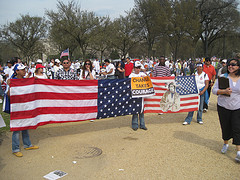By: Emily Pierce, Associate Attorney at Maged Rost
L-1 visas for intracompany transferees are popular options for some foreign nationals who would like to work for a US affiliate of the foreign company temporarily.[1] This article provides a general overview of the L-1 visa and its eligibility requirements, while subsequent posts will delve deeper into some of the nuances of this non-immigrant option.
To be eligible for admission into the United States as an intracompany transferee, the petitioning employer first must establish that the foreign national beneficiary worked for a company outside of the United States continuously for one year.[2] This year of employment abroad must occur within the three years preceding the beneficiary’s application for admission into the United States.[3] For example, if a beneficiary submits his application for admission on January 15, 2015, his continuous year of employment abroad must have occurred between January 15, 2012 and January 15, 2015.
Moreover, the year of employment abroad must be in a capacity that is “managerial, executive, or involves specialized knowledge.”[4] Practically speaking, managers and executives often have similar roles within in a business, and the particular job title may not hold significance. However, these job titles and, more importantly, job descriptions are terms of art in immigration law, and therefore the words “managerial,” “executive,” and “specialized knowledge” have very particular meanings that must be understood when applying for an L-1 visa.[5]
Second, the petitioner must prove that the beneficiary’s foreign employer and proposed U.S. employer are “qualifying organizations”[6] A foreign employer and a U.S. employer are qualifying organizations if they are a parent, branch, affiliate, or subsidiary of each other.[7] Additionally, the U.S. employer must be “doing business” in the United States and in at least one other country directly or through a parent, branch, affiliate, or subsidiary for the duration of the beneficiary’s stay in the United States.[8]
The third requirement is that the beneficiary’s proposed employment in the U.S. must also be in a capacity that is “managerial, executive, or involves specialized knowledge.”[9] A future blog post will discuss the definitions of these terms of art.
When the beneficiary is coming to the United States as a manager or executive to open or to be employed in a new office, the petitioner must provide evidence that it satisfies three additional requirements.[10] First, the petitioner must establish that it has secured sufficient physical premises to house the new office.[11] Second, the petitioner must demonstrate that the beneficiary’s employment abroad was in an executive or managerial capacity.[12] Third, the petitioner must prove that within one year of the approval of the petition, the new U.S. operation will support an executive or managerial position.[13] A new office is one that has been doing business for less than one year in the United States.[14]
Finally, if the beneficiary is an owner or major stockholder of the company, the petitioner must establish that the beneficiary’s services are to be used for a temporary period only, and that the beneficiary will be transferred to an assignment abroad upon the completion of the temporary services in the United States.[15]
This article is a general overview of L-1 visas and it is not meant to replace the advice of an attorney. If you are interested in learning more, please consult with an experienced immigration attorney. Please return to www.immigrantconnect.com for future posts containing more information about L-1 visas.
[1] INA § 101(a)(15)(L).
[2] INA § 101(a)(15)(L), 8 C.F.R. § 214.2(l)(1)(i), 8 C.F.R. § 214.2(l)(1)(ii)(A).
[3] Id.
[4] 8 C.F.R. § 214.2(l)(3)(iv).
[5] 8 C.F.R. § 214.2(l)(1)(ii)(B) – (D).
[6] INA § 101(a)(15)(L), 8 C.F.R. § 214.2(l)(1)(i).
[7] 8 C.F.R. § 214.2(l)(1)(ii)(G).
[8] 8 C.F.R. § 214.2(l)(1)(ii)(G)(2), 8 C.F.R. § 214.2(l)(1)(ii)(H).
[9] INA § 101(a)(15)(L), 8 C.F.R. § 214.2(l)(1)(i).
[10] 8 C.F.R. § 214.2(l)(3)(v).
[11] 8 C.F.R. § 214.2(l)(3)(v)(A).
[12] 8 C.F.R. § 214.2(l)(3)(v)(B).
[13] 8 C.F.R. § 214.2(l)(3)(v)(C).
[14] 8 C.F.R. § 214.2(l)(1)(ii)(F).
[15] 8 C.F.R. § 214.2(l)(3)(vii).

